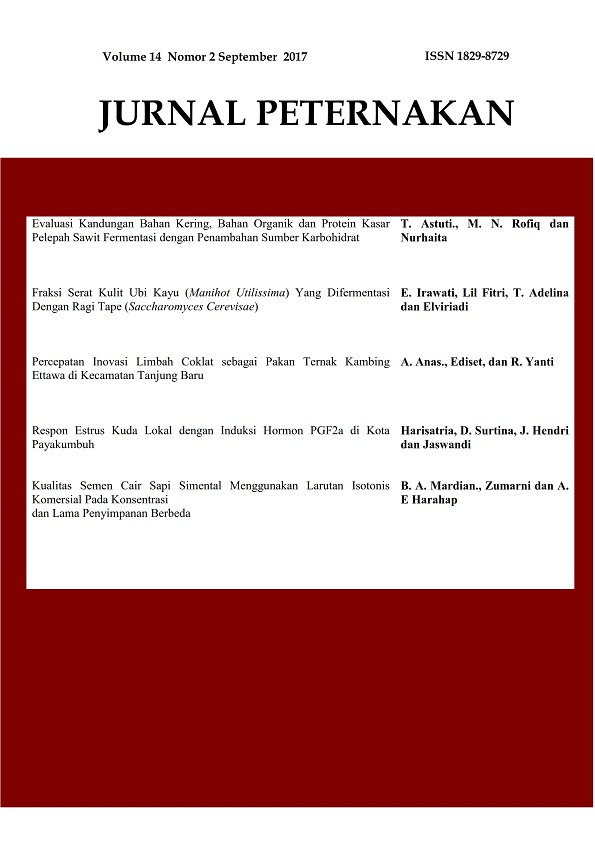PERCEPATAN INOVASI LIMBAH COKLAT SEBAGAI PAKAN TERNAK KAMBING ETTAWA DI KECAMATAN TANJUNG BARU
DOI:
https://doi.org/10.24014/jupet.v14i2.3656Keywords:
Adoption, Innovation, Waste Cocoa, Feed, Ettawa Cross BreedAbstract
ABSTRACT
This research aims to determine: a) the acceleration of innovation adoption cocoa waste as animal feed of Ettawa Cross Breed in the district of Tanjung Baru Tanah Datar, b) problems encountered in the implementation of the waste cocoa breeders as animal feed of Ettawa Cross Breed in the district of Tanjung Baru Tanah Datar. This research used survey, where respondents in the sample in this research is the goat breeders in the district of Tanjung Baru as many as 30 people. The data collected are primary data with the aid of questionnaires and secondary data with study of literature and related agencies. The results of this research indicate that the size of the adoption of the innovation seen on the velocity or the time interval between the receipt of the information and the application is done in the district of Tanjung Baru classified as fast (less than 1 week) 66.67%, broad application of innovation or the proportion of the number of animals that have been given the new innovations in the district of Tanjung Baru is applied by 76.67%, and intensification quality by comparing with recommended application submitted by extension in the district of Tanjung Baru is good at 73.33%.
References
Anwar, S. Fuad, M dan Amrizal, A. 2009. Ilmu Penyuluhan Pertanian. Universitas Andalas. Padang.
Badan Pusat Statistik. 2011. Kabupaten Tanah Datar dalam Angka. Badan Pusat Statistik Kabupaten Tanah Datar. Tanah Datar.
Berlo, D. K. 1960. The Process of Communication: An Introduction to Theory and Practice. New York: Holt, Rinehart and Winston, Inc.
Buch, R. 2001. Dua Tongkol Jagung. Pedoman Pengembangan Pertanian Berpangkal pada Rakyat. Edisi Kedua. Yayasan Obor Indonesia, Jakarta.
Hanafi, A. 1987. Memasyarakatkan Ide-Ide Baru. Surabaya: Penerbit Usaha Nasional
Kartasapoetra, AG. 1994. Teknologi Penyuluhan Pertanian. Bumi Aksara. Jakarta.
Mardikanto.1993. Penyuluhan Pembangunan Pertanian. UNS Press. Surakarta.
Mardikanto.1996. Penyuluhan Pembangunan Kehutanan. UNS Press. Surakarta.
Mardikanto. 2009. Redefinisi dan Revitalisasi Penyuluhan Pertanian. PUSPA. Surakarta.
Marzuki, C. 1999, Metodologi Riset. Jakarta: Erlangga.
Rogers EM, Schoemaker FF. 1995. Communication of Innovations: A Cross Cultural Approach. Revised Edition. New York: The Free Press.
Sidadora, Y. 2010. Persepsi dan Adopsi Peternak Sapi Potong. Skripsi Fakultas Peternakan Universitas Andalas. Padang
Singarimbun, M. dan Effendi S. 2006. Metode Penelitian Survai. LP3ES. Yogyakarta.
Slamet, Y. 2006. Metode Penelitian Sosial. UNS Press. Surakarta.
Wirartha, Made.2005. Metode Penelitian Sosial Ekonomi. CV Andi Offset. Yogyakarta.
Downloads
Published
Issue
Section
License
The Authors submitting a manuscript do so on the understanding that if accepted for publication, copyright of the article shall be assigned to Jurnal Peternakan and published by Fakultas Pertanian dan Peternakan Universitas Islam Negeri Sultan Syarif Kasim Riau as publisher of the journal.
Authors who publish with this journal agree to the following terms:
Authors automatically transfer the copyright to the journal and grant the journal right of first publication with the work simultaneously licensed under a Creative Commons (CC BY) that allows others to share the work with an acknowledgement of the work's authorship and initial publication in this journal.
Authors are able to enter into separate permission for non-exclusive distribution of the journal's published version of the work (e.g., post it to an institutional repository or publish it in a book), with an acknowledgement of its initial publication in this journal.
Authors are permitted and encouraged to post their work online (e.g., in institutional repositories or on their website) prior to and during the submission process, as it can lead to productive exchanges, as well as earlier and greater citation of published work (See The Effect of Open Access).

